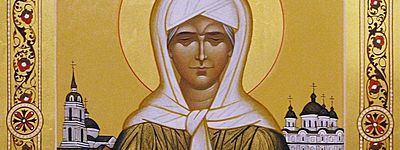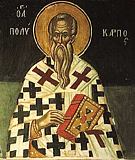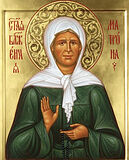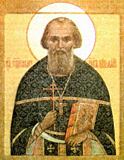 Hieromartyr Polycarp, bishop of Smyrna (167). Finding of the Relics of St. Matrona of Moscow (1998)
Hieromartyr Polycarp, bishop of Smyrna (167). Finding of the Relics of St. Matrona of Moscow (1998)
St. Alexander, founder of the Monastery of the Unsleeping Ones, Constantinople (ca. 430). Sts. John, Antioch, Antoninus, Moses, Zebinas, Polychronius, Moses (another), and Damian, ascetics near Cyrrhus (5th c.). St. Polycarp, monk, of Bryansk (1620-1621). St. Nazarius, abbot of Valaam Monastery (1809). St. Seraphim (Zenobius), schema-metropolitan of Tetritskaro, Georgia, monk of Glinsk Monastery (1985).
New Hieromartyr Michael Edlinsky, archpriest, of Kiev (1938). New Hieromartyr Nicholas Dmitrov, archpriest, of Zavidovo (Tver) (1938).
Virgin-martyr Martha at Astorga (Spain) (251). 73 Martyrs of Sirmium under Diocletian (303). St. Gorgonia (372), sister of St. Gregory the Theologian. Martyrs Syncrotas, Antigonus, Rutilus, Libius, Senerotas and Rogatianus, at Sirmium (4th c.). St. Florentius, confessor, of Seville (ca. 485). St. Felix, bishop of Brescia (ca. 650). St. Jurmin, prince, of East Anglia (653). St. Mildburga, abbess of Wenlock (715). St. Boswell (Boisil), abbot, of Melrose (ca. 661). St. John Theristes (the Harvester) of Stylos in Calabria (11th c.). St. Damian of Esphigmenou, Mt. Athos (1280). St. Cosmas of Zographou, Mt. Athos (1281). St. Moses, monk of White Lake (1480). New Monk-martyr Damian of Philotheou and Kissavos, at Larissa (1568). New Hieromartyr Lazarus of the Peloponnese (ca. 1618).
Repose of Archimandrite Agapit (Belovidov) of Optina Monastery (1922) and Elder Sabbas (Stavrobouniotes) of Cyprus (1985).
Thursday. [I John 4:20–5:21; Mark 15:1–15]
This is the victory that overcometh the world,
even our faith (I John 5:4)—the Christian
faith. To overcome the world—what does that mean?
Not to exterminate all those who love the world, or to
annihilate and destroy all which is loved by the world. It
means rather that while living amidst those who love the
world and moving amidst customs loved of the world, we
live and be alien to everyone and everything. As soon as
you have rejected the world and everything worldly, you
have by this very action overcome the world. But who
teaches you to reject the world and who gives you strength
for this? Our [Orthodox] Faith gives the strength. It
discloses the destructiveness of the delusions of the
world and inspires the desire to free oneself of their
nets. Then, when one resolves to break these bonds,
repents and approaches the Mysteries of
renewal—baptism or repentance—faith allows him
to mystically feel the sweetness of a life opposed to the
world, a sweetness with which all the pleasures of the
world cannot in any way enter into comparison. As a
result, a loathing for everything worldly dwells in the
heart, which actually is overcoming the world. But in this
mystical action, as a result of which loathing for the
world is born, the power to steadfastly abide in this
loathing and alienation from the world also is granted;
and this is a victory decisive and lasting.


![]() Hieromartyr Polycarp, bishop of Smyrna (167). Finding of the Relics of St. Matrona of Moscow (1998)
Hieromartyr Polycarp, bishop of Smyrna (167). Finding of the Relics of St. Matrona of Moscow (1998) 


















